KSK-74: Dual Histamine H3 and Sigma-2 Receptor Ligand with Anti-Obesity Potential
By Kamil Mika, Małgorzata Szafarz, Monika Zadrożna, Barbara Nowak, Marek Bednarski, Katarzyna Szczepańska, Krzysztof Pociecha, Monika Kubacka, Noemi Nicosia, Izabela Juda, Katarzyna Kieć-Kononowicz, and Magdalena Kotańska
Excerpt from the article published in International Journal of Molecular Sciences 2022 23, no. 13: 7011. Published: 24 June 2022. DOI: https://doi.org/10.3390/ijms23137011
Editor’s Highlights
- Ligands for H3/sigma-2 receptors promote the formation of new adipocytes, protecting against the adverse consequences of obesity, including insulin resistance.
- Potent H3 histamine and sigma-2 receptor ligands have proven efficacy in preventing weight gain in a rat model of excessive eating.
- The in vivo pharmacological activity of the tested ligands appears to correlate with the affinity for the sigma-2 receptors.
Abstract
Many studies involving compounds that enhance histamine release, such as histamine H3 receptor (H3R) antagonists, have shown efficacy in inhibiting weight gain, but none have passed clinical trials. As part of the search for H3 receptor ligands that have additional properties, the aim of this study is to evaluate the activity in the reduction in weight gain in a rat model of excessive eating, as well as the impact on selected metabolic parameters, and the number and size of adipocytes of two new H3R antagonists, KSK-60 and KSK-74, which also exert a significant affinity at the sigma-2 receptor. Compounds KSK-60 and KSK-74 are homologues and the elongation of the distal part of the molecule resulted in an approximate two-fold reduction in affinity at H3R, but simultaneously an almost two-fold increase in affinity at the sigma-2 receptor. Animals fed palatable feed and receiving KSK-60 or KSK-74 both at 10 mg/kg b.w. gained significantly less weight than animals in the control obese group. Moreover, KSK-74 significantly compensated for metabolic disturbances that accompany obesity, such as an increase in plasma triglyceride, resistin, and leptin levels; improved glucose tolerance; and protected experimental animals against adipocyte hypertrophy. Furthermore, KSK-74 inhibited the development of inflammation in obesity-exposed adipose tissue. The in vivo pharmacological activity of the tested ligands appears to correlate with the affinity at the sigma-2 receptors; however, the explanation of this phenomenon requires further and extended research.
1. Introduction
The World Health Organization (WHO) considers obesity to be one of the most serious public health concerns of the present century. The WHO has estimated that, globally, there are more than 650 million people with obesity (BMI ≥ 30 kg/m2) and, in 2020, over 39 million children under the age of 5 years were overweight or obese [1]. Further concerns arise from the strong correlation between obesity or being overweight and the progression of cardiovascular and gastrointestinal diseases and diabetes, along with the increased risk of developing pancreatic, kidney, colorectal, and gallbladder cancer, as well as musculoskeletal disorders and infections [2,3]. Considering its high impact not only on health, but also on the economy and society, over the past few years, the pharmaceutical industry and many research groups have focused on the development of an effective and safe drug to fight this global epidemic. The numerous pharmaceutical anti-obesity treatment options (e.g., dinitrophenol, fenfluramine, fenfluramine-phentermine, sibutramine, and rimonabant) were associated with severe side effects and had to be removed from the market by both the Food and Drug Administration (FDA) and by the European Medicine Agency (EMA). In the treatment of obesity, both of these agencies (EMA and FDA) have only approved the use of Orlistat, Liraglutide, and the combination of Bupropion and Naltrexone [3].
Considering the involvement of the histaminergic system in food intake and body weight regulation through the interaction with histamine receptors in the CNS, many recent studies have focused on the histamine H3 receptor (H3R) as a potential target for anti-obesity therapies [4,5,6]. H3R is a presynaptic autoreceptor abundantly expressed in the CNS and modestly found peripherally. Its activation leads to a negative feedback modulation of histamine synthesis and inhibition of its release from histaminergic neurons. Furthermore, histamine postsynaptic H3R has been shown to modulate the release of other neurotransmitters, including dopamine, acetylcholine, serotonin, glutamate, substance P, norepinephrine, and γ-aminobutyric acid [4]. To date, many studies involving compounds that enhance histamine release, such as H3R antagonists, have shown efficacy in inhibiting weight gain [5,6,7,8,9]. Histamine also increases the lipolysis of white adipose tissue, thus altering peripheral metabolism [10]. This fact may justify the strong interest in the search for new, effective, and safe therapeutic agents to treat obesity among H3R ligands.
To date, numerous molecules with antagonist/inverse agonist properties have been synthesized from the proposed H3R pharmacophore structure that contains a basic moiety—mostly a tertiary amine substituted by a linking alkyl group, often incorporating another functionality (frequently polar) [5,11,12]. Early preclinical studies revealed the efficacy of many H3 receptor antagonists in reducing body weight in rodent models; however, only SCH-497079 and HPP404 were selected to enter phase II clinical trials. Among these, the antagonist SCH-497070 has recently completed the trials. Unfortunately, both molecules were not considered for further development due to the side effects [13]. Furthermore, A-331440, a selective H3R antagonist, was found to be useful in decreasing body weight. The administration of the highest dose of A-331440 in mice fed a high-fat diet induced weight loss comparable to mice fed a low-fat diet along with lower leptin levels and normalized insulin tolerance. Despite its effectiveness, it was excluded from clinical trials due to genotoxicity [14].
Promising results were obtained from studies on Betahistine, a H3R antagonist and H1R agonist (registered for the treatment of vertigo and Meniere’s disease). Betahistine induced significant weight loss in an obese animal after olanzapine treatment [15,16]. In addition, in our previous work, we described the effect of the repeated administration of Betahistine on body weight in a rat model of excessive eating. We showed that long-term Betahistine administration slows weight gain and increases high-density lipoprotein (HDL) levels [17]. A clinical study compared the effect of Betahistine with Orlistat® in obese adults [18]. The experiment did not show significant differences between the two molecules in reducing body weight and waist circumference. Apart from Betahistine, Pitolisant is the second approved (in narcolepsy) histamine H3R antagonist. Kotańska et al. (2018) investigated the effect of the antagonist/inverse agonist, Pitolisant (registered under the name of Wakix®), on body weight and metabolic disturbances in a model of induced obesity in mice. Pitolisant administered intraperitoneally (i.p.) at a dose of 10 mg/kg b.w. for 14 days showed a positive influence on body weight, glucose tolerance, and lipid profile [19].
In our previous publication, we found that KSK19, one of the most active and selective ligands of H3 receptors, exerted a favorable impact on body weight, after multiple administrations at a dose of 15 mg/kg b.w., in the mice obesity model [20]. Considering its promising anti-obesity properties, our research group chose the KSK19 lead structure as a reference to develop new selective H3R ligands. Our recent study demonstrated high efficacy in inhibiting weight gain in a model of excessive eating and favorable pharmacokinetic properties for four of the ligands tested: KSK-61 and KSK-63, KSK-59 and KSK-73 [21,22]. Based on our recent work, we included two new histamine H3R antagonists in our study, KSK-60 and KSK-74 (Figure 1) [12], which are structural analogs of compounds KSK-59 and KSK-73. We used phentermine as the reference compound, which is currently registered in some countries (also in combination with Topiramate) for the treatment of obesity [23]. Our compounds have also been shown to exert a significant affinity at the sigma-2 receptor [24]. Interestingly, looking at the results for the compounds KSK-60 and KSK-74, which are the subject of this study, the elongation of the distal part of the molecules (acetyl vs. propionyl derivatives, Figure 1) resulted in an approximate two-fold reduction in affinity at H3R, but simultaneously an almost two-fold increase in affinity at the sigma-2 receptor. Therefore, a comparison of the activity in the reduction in weight gain in the model of excessive eating and the impact on selected metabolic parameters, as well as the number and size of adipocytes after the administration of these two compounds, can provide valuable information on the importance of this affinity.
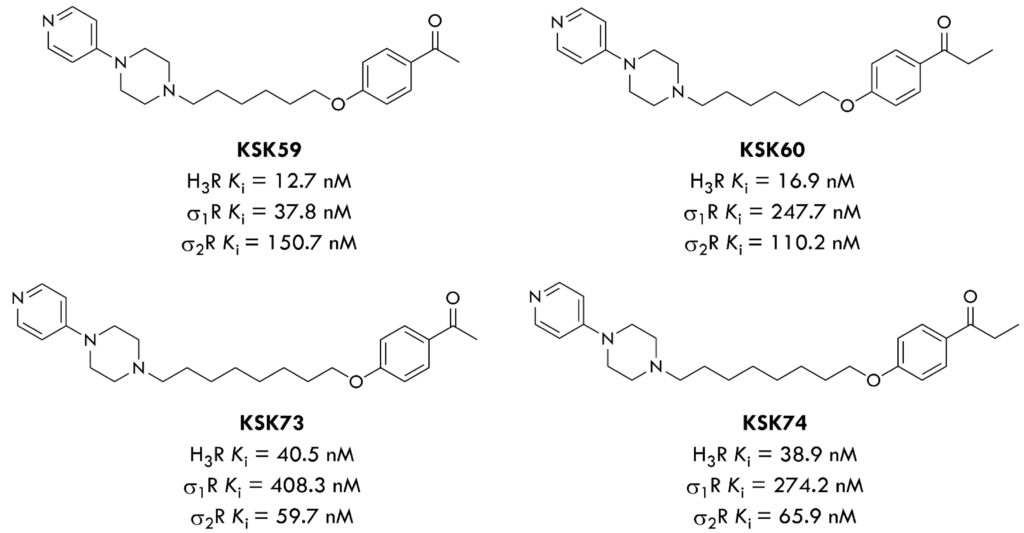
Structures of compounds evaluated in our previous work (KSK-59, KSK-73) and in our present work (KSK-60, KSK-74). Affinity values of the ligands tested at the H3R [12] and the sigma-1 and sigma-2 receptors [24]. Structure and purity confirmation data of compounds KSK-60 and KSK-74 were shown in Supplement File S1.
2. Results
2.1. The Intrinsic Activity at H3R
The intrinsic activity towards H3R of all compounds tested was examined using two commercial methods, and the obtained IC50 values, despite the slight differences, were comparable. The compound KSK-60 proved to be a more potent antagonist of H3R, with an IC50 value ranging from 0.8 to 1.5 nM, depending on the assay method. The compound KSK-74 was slightly less active in blocking H3R, and the IC50 value for this compound ranged from 23 to 32 nM depending on the assay method (Table 1, Figure 2). Summing up, both tested compounds showed significant antagonist properties for H3R, with KSK-60 acting more effectively.

The intrinsic activity at the histamine H3 receptor of the tested compounds presented as concentration-dependence curves. The values (%) obtained by two methods, LANCE cAMP (a) and Aequoscreen (b), are expressed as a percentage of the action of the full agonist (R)-alpha-methylhistamine at the dose of EC80 (100%).
| Compound | LANCE Ultra cAMP IC50 [nM] | Aequoscreen IC50 [nM] |
|---|---|---|
| (R)-alpha-methylhistamine | 1.05 ± 0.1 | 10.6 ± 2.2 |
| Clobenpropit | – | 1.1 ± 0.3 |
| Thioperamide | 14.52 ± 3.2 | – |
| KSK-60 | 0.78 ± 0.1 | 1.49 ± 0.2 |
| KSK-74 | 23.22 ± 3.6 | 31.9 ± 0.5 |
The IC50 values for the antagonist dose–response with the reference agonist ((R)-alpha-methylhistamine) at a final concentration equivalent to EC80 obtained by two methods: LANCE Ultra cAMP and Aequoscreen.
2.2. Effect of KSK-60, KSK-74, or Phentermine on Body Weight and Caloric Intake
A higher weight gain was observed in rats in the palatable diet + vehicle group than in rats in the Standard diet + vehicle group (p < 0.01, p < 0.001, Figure 3a,b). Animals fed palatable feed and receiving KSK-60 or KSK-74 both at 10 mg/kg b.w. gained significantly less weight than animals in the palatable diet + vehicle group (p < 0.05, p < 0.01, respectively, Figure 3b). No differences in body weight were observed in the palatable diet + KSK-60 or palatable diet + KSK-74 groups (both 1 mg/kg) compared to the palatable diet + vehicle group. Rats fed palatable feed and treated with phentermine gained less weight than rats receiving palatable diet + vehicle (p < 0.01, Figure 3b). In rats fed a palatable diet and treated with compounds KSK-60 or KSK-74 (10 mg/kg), we recorded a significant inhibition of body weight gain around the 10th day of the experiment, and this condition persisted until the 28th day (the end) of the experiment. The results are shown in Figure 3c,d.

Cumulative changes in body weight
(a,b), body weight during administration of the tested compounds or phentermine, (c) KSK-60 (10 mg/kg) and phentermine (7 mg/kg), (d) KSK-74 (10 mg/kg) and phentermine (7 mg/kg). Results are expressed as means ± SD, n = 6. Multiple comparisons were made using two-way ANOVA, Tukey’s post hoc tests. * Significant against standard diet + vehicle group vs. palatable diet + vehicle group; ^ significant against the tested compound administered group vs. palatable diet + vehicle group; # significant against palatable diet + phentermine group vs. palatable diet + vehicle group; *, ^, # p < 0.05, **, ^^, ## p < 0.01, ***, ^^^, ### p < 0.001.
KSK-74 or KSK-60 administered i.p. for 28 days at a dose of 10 mg/kg b.w. or phentermine administered at a dose of 7 mg/kg b.w. did not significantly influence the amount of calories consumed by animals in the test groups compared to the control group fed palatable feed (Figure 4). In KSK-74- or phentermine-treated groups, rats ate slightly less calories (lack of significance vs. both control groups). Rats treated with KSK-74 at a dose of 10 mg/kg b.w. consumed significantly less milk in the first and second weeks and significantly less peanuts in the fourth week of treatment vs. control group fed palatable feed (Figure 5).

Effect of administration of the tested compounds or phentermine on calorie intake compared to control groups.
Results are expressed as means ± SD, n = 3. Comparisons were made using the Kruskal–Wallis test followed by the Dunn post hoc test * Significant against control rats fed standard diet; * p < 0.05, ** p< 0.01.

Amount of particular taste products’ intake: (a) cheese, (b) chocolate, (c) peanuts, (d) milk, (e) feed, by rats from group treated with KSK-74 compared to rats from control group fed palatable feed. Results are expressed as means ± SD, n = 3. Multiple comparisons were made using two-way ANOVA, Bonferroni’s post hoc tests. ^ Significant against the tested compound administered group vs. palatable diet + vehicle group; ^ p < 0.05.
2.3. Effect of KSK-60, KSK-74, or Phentermine on Fat Pads and Plasma Triglyceride Levels
A statistically higher amount of fat pads in the peritoneal cavity was observed in the palatable diet + vehicle group than in the standard diet + vehicle group (p < 0.05, Figure 6a). In the palatable diet + KSK-74 (10 mg/kg) group, fewer fat pads were observed than in the palatable diet + vehicle group (p < 0.001, Figure 6a). Animals fed palatable feed and receiving KSK-60 at 10 mg/kg or phentermine at 7 mg/kg had fewer peritoneal fat pads compared to animals receiving vehicle and fed palatable feed, since there was no statistically significant difference between the amount of adipose tissue in these groups vs. the control group fed standard feed (Figure 6a). Compared to the standard diet + vehicle group, higher plasma triglyceride levels were observed in rats fed palatable feed and receiving vehicle (p < 0.01, Figure 6b). Animals fed palatable feed and receiving KSK-74 at 10 mg/kg or phentermine had lower plasma triglyceride levels than rats from the palatable diet + vehicle group (p < 0.05, p < 0.01, respectively, Figure 6b). No differences in plasma triglyceride levels were observed between the palatable diet + vehicle group and the palatable diet + KSK-60 group (10 mg/kg) (Figure 6b).

Mass of adipose pads at the end of the experiment
(a), effect of the tested compounds or phentermine on the plasma level of triglyceride (b). Results are expressed as means ± SD, n = 6. Comparisons were made using one-way ANOVA, Tukey’s post hoc tests. * vs. standard diet + vehicle group; ^ vs. palatable diet + vehicle group; ^, * p < 0.05, ^^, ** p < 0.01, ^^^ p < 0.001.
2.4. Effect of KSK-60, KSK-74, or Phentermine on the Numerical Density of Adipocytes
Morphometric analysis of adipose tissue showed a decrease in the number of adipocytes per 0.1 mm2 of cross-sectional area both in the palatable diet + vehicle and the palatable diet + KSK-60 (10 mg/kg) groups compared to the standard diet + vehicle group (17.69 ± 1.28 vs. 28.73 ± 1.54, p < 0.05 and 18.02 ± 1.38 vs. 28.73 ± 1.54, p < 0.05, respectively). The highest number of adipocytes per unit area was observed in the adipose tissue of animals in the palatable diet + KSK-74 (10 mg/kg) group (34.78 ± 4.78) and was almost two times higher than in the palatable diet + vehicle (p < 0.05) and the palatable diet + KSK-60 (10 mg/kg) groups (p < 0.05), confirming the protective effect of the KSK-74 compound against adipocyte hypertrophy. The mean number of adipocytes in the adipose tissue of the palatable diet + phentermine (7 mg/kg) group was more similar to the results of the palatable diet + vehicle group than to the results of the non-obese control group, but these differences were not significant in both cases (Figure 7).

Adipocytes numerical density in Masson’s trichrome staining of adipose tissue from the studied groups of rats.
Representative microphotographs of tissue sections from the standard diet + vehicle group showing the normal architecture of adipocytes (a); palatable diet + vehicle (b) and palatable diet + KSK-60 10 mg/kg (c) showing a decrease in the number of adipocytes per 0.1 mm2; palatable diet + KSK-74 10 mg/kg (d), which has more adipocytes compared to palatable diet + vehicle; and palatable diet + phentermine 7 mg/kg (e). Bar = 20 mm. (f) Adipocytes’ numerical density expressed as means ± SD, n = 6. Comparisons were made using the Kruskal–Wallis test followed by the Dunn post hoc test; * significant vs. standard diet + vehicle group; ^ significant vs. palatable diet + vehicle group * ^ p < 0.05.
2.5. Effect of KSK-60, KSK-74, or Phentermine on the Presence of Pathological Features of Adipose Tissue Inflammation
Histological analysis was performed to identify the pathological features of adipose tissue inflammation. Many inflammatory cells infiltrated the area of adipocytes and the perivascular area, mainly in the adipose tissue of rats from the palatable diet + vehicle and palatable diet + KSK-60 (10 mg/kg) groups. On the other hand, slightly less inflammatory infiltrates, rather in the form of local leukocyte clusters, were observed in tissues of animals from the palatable diet + phentermine (7 mg/kg) and the palatable diet + KSK-74 (10 mg/kg) groups. Masson’s trichrome staining of adipose tissue sections revealed a frequent occurrence of trichrome-positive fibrotic streaks in tissue from animals of all groups, except rats from the standard diet + vehicle group. In addition, no leukocyte infiltrates were observed in this group (Figure 8).
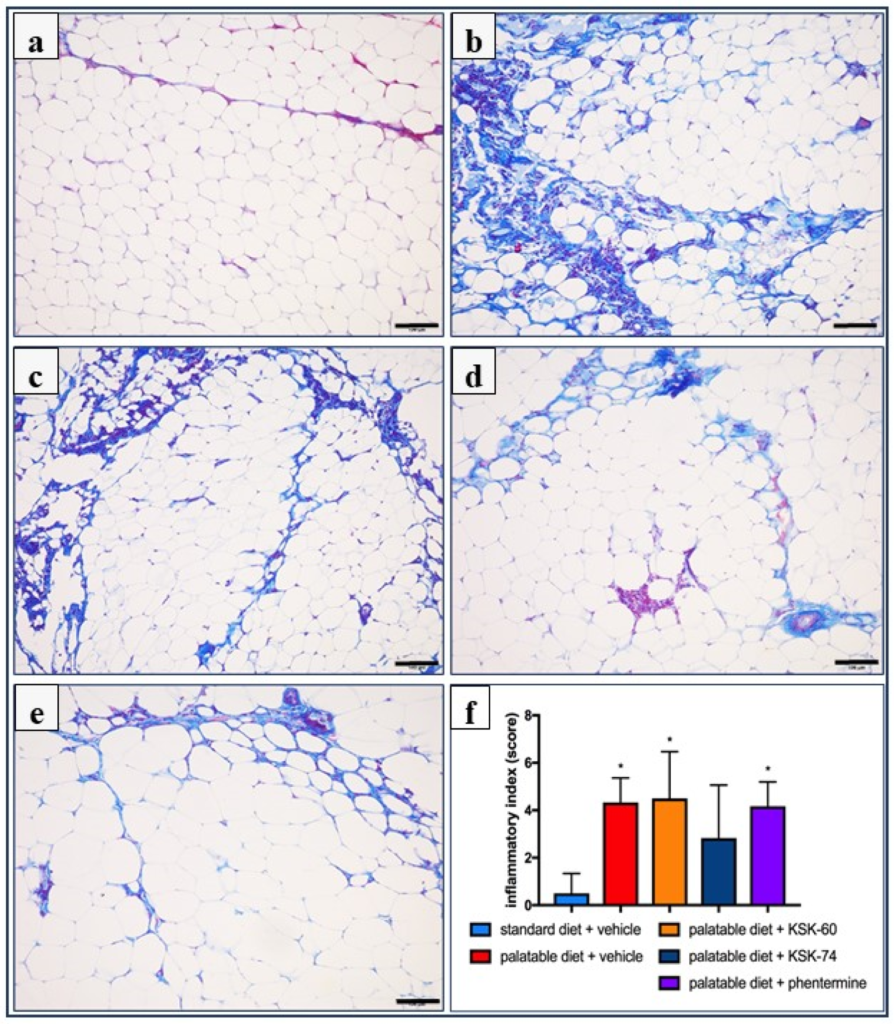
Representative histological pictures of Masson’s trichrome-stained adipose tissue sections (bar = 100 mm).
(a) Standard diet + vehicle group, (b) palatable diet + vehicle, (c) palatable diet + KSK-60 10 mg/kg, (d) palatable diet + KSK-74 10 mg/kg, (e) palatable diet + phentermine 7 mg/kg. Many inflammatory cells infiltrating the area of the adipocytes and trichrome-positive fibrotic streaks are visible in the adipose tissue of all studied groups, except the rats in the standard diet + vehicle group. (f) Inflammatory index expressed as means ± SD, n = 6. Comparisons were made using the Kruskal–Wallis test followed by the Dunn post hoc test; * significant vs. standard diet + vehicle group; * p < 0.05.
In the adipose tissue of rats in the palatable diet + phentermine (7 mg/kg) group, our attention was focused on the marked capillary congestion and frequent appearance of crown-like structures formed by mononuclear cells surrounding a presumably dead adipocyte (Figure 9).
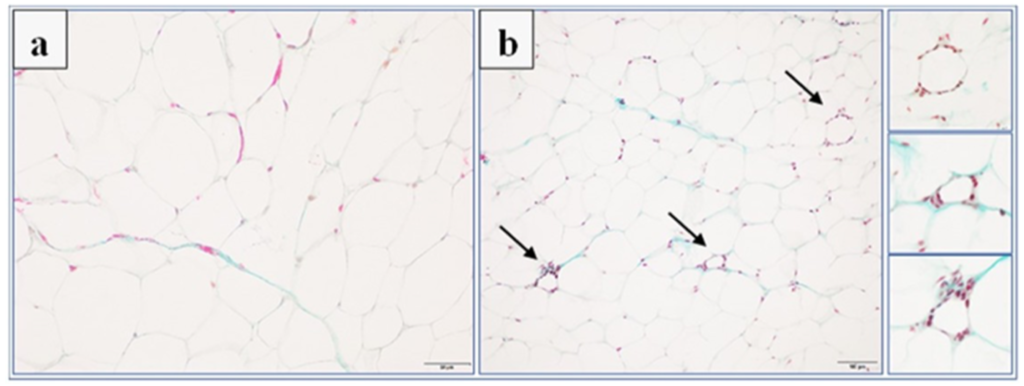
Histological section of adipose tissue from the palatable diet + phentermine 7 mg/kg group stained with Masson’s trichrome showing capillary congestion (a) and the frequent appearance of crown-like structures (arrow) formed by mononuclear cells surrounding a presumably dead adipocyte (b). Bar = 50 mm (a) and 100 mm (b).
All these observations were further confirmed by the histological scoring of inflammation and presented as the inflammatory index. The number of rats in each group, with the appropriate histological grade for the independently assessed components of the inflammatory index is presented in Table 2. The inflammatory index of the adipose tissue of the studied animals was statistically significantly higher in the palatable diet + vehicle (4.33 ± 0.42, p < 0.05), palatable diet + KSK-60 (10 mg/kg) (4.5 ± 0.80, p < 0.05), and palatable diet + phentermine (7 mg/kg) (4.16 ± 0.48, p < 0.05) groups compared to the standard diet + vehicle group (0.5 ± 0.34) (Figure 8f).
2.6. Effects of KSK-60, KSK-74, or Phentermine on IL-6 and MCP-1 Levels in Adipose Tissue
There were no significant changes in IL-6 levels in adipose tissue between the standard diet + vehicle and the palatable diet + vehicle control groups. IL-6 levels were reduced in adipose tissue only in animals fed palatable feed and receiving KSK-74 at 10 mg/kg, compared to the group receiving a palatable diet and vehicle (p < 0.01, Figure 10a). Higher levels of MCP-1 were observed in the adipose tissue of rats in the palatable diet + vehicle group compared to the adipose tissue of rats in the standard diet + vehicle group (p < 0.001, Figure 10b). The administration of KSK-74 at a dose of 10 mg/kg b.w. decreased the level of MCP-1 in the rat’s adipose tissue, compared to the rats that received palatable feed and vehicle (p < 0.001, Figure 10b).
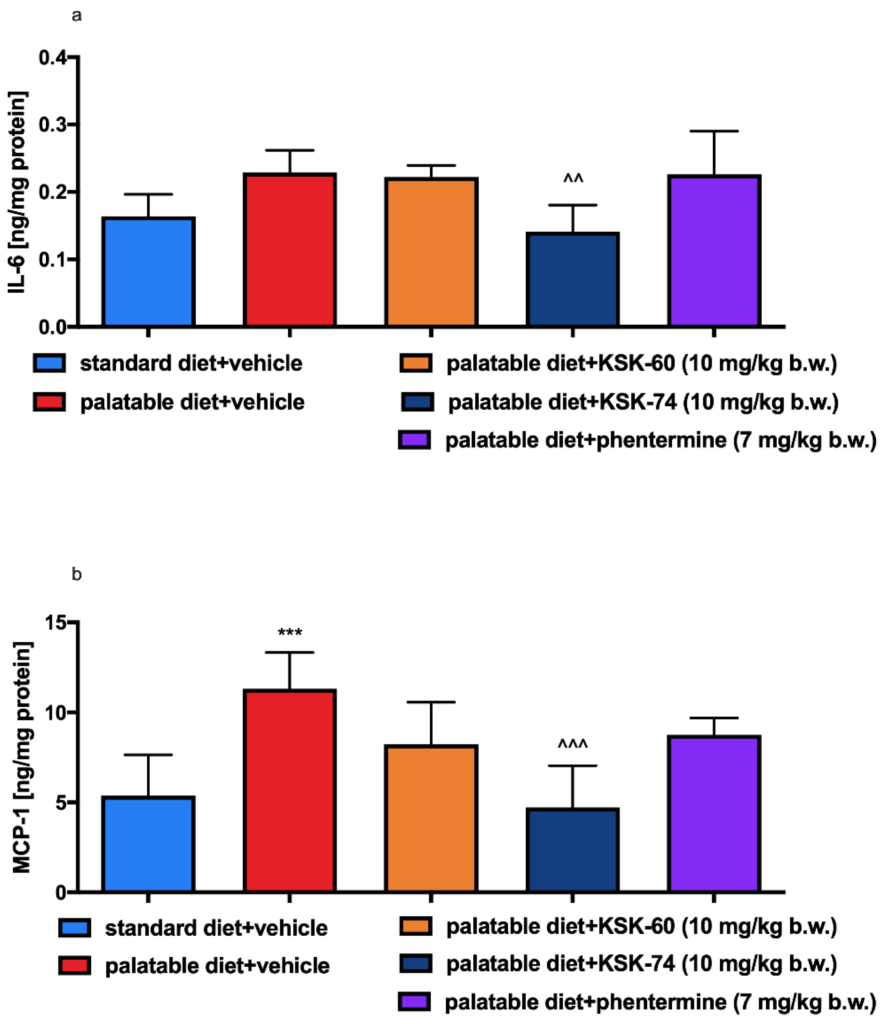
Effect of administration of the tested compounds or phentermine on adipose tissue levels of (a) IL-6 and (b) MCP-1. Results are expressed as means ± SD, n = 6. Comparisons were made using one-way ANOVA, Tukey’s post hoc test; * significant vs. standard diet + vehicle group; ^ significant vs. palatable diet + vehicle group ^^ p < 0.01, ***, ^^^ p < 0.001.
2.7. Effect of KSK-60, KSK-74, or Phentermine on Leptin and Resistin Levels in Adipose Tissue
There were significant changes in leptin and resistin levels in adipose tissue between rats in control groups that received different diets (standard or palatable) and vehicle (p < 0.05, Figure 11a,b). Compared to the palatable diet + vehicle group, reduced levels of leptin and resistin were observed in adipose tissue from animals that received i.p. KSK-74 10 mg/kg (p < 0.001, p < 0.01, Figure 11a,b). Phentermine did not influence the concentration of leptin or resistin.
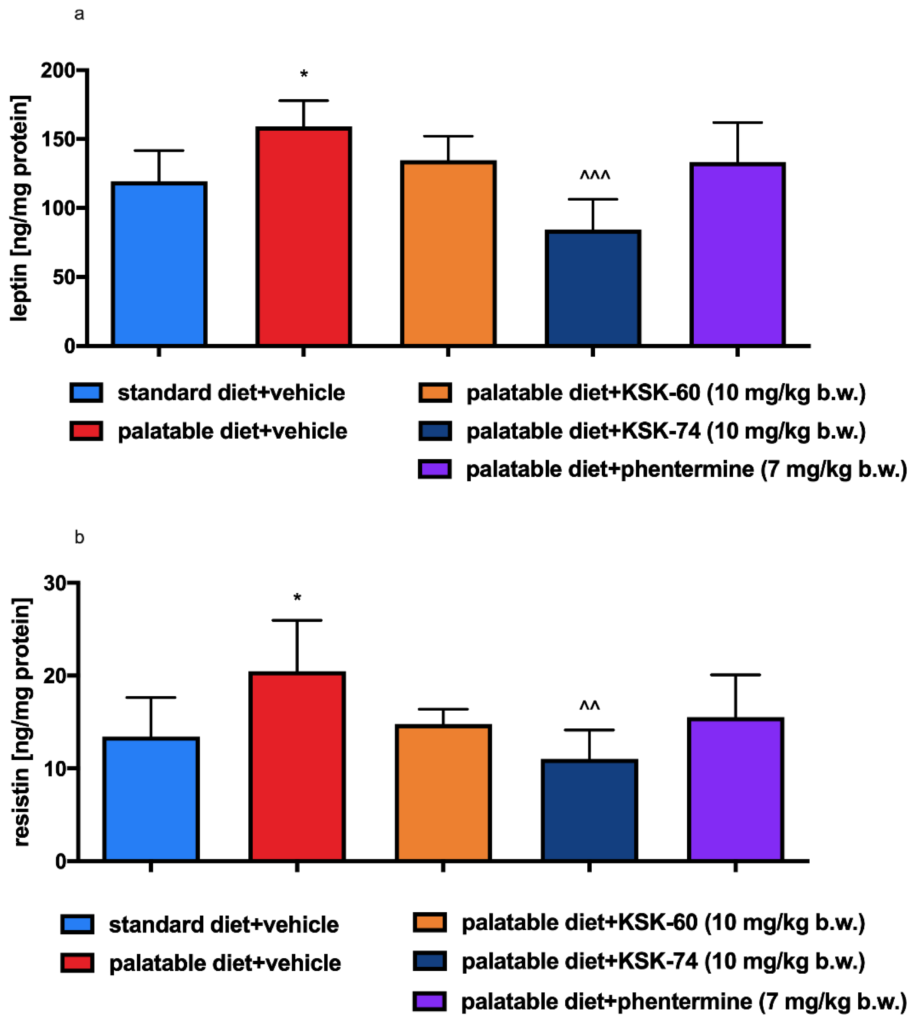
Effect of the tested compounds or phentermine on adipose tissue levels of (a) leptin and (b) resistin. Results are expressed as means ± SD, n = 6. Comparisons were performed by one-way ANOVA, Tukey’s post hoc test; * significant vs. standard diet + vehicle group; ^ significant vs. palatable diet + vehicle group * p < 0.05, ^^ p < 0.01, ^^^ p < 0.001.
2.8. Glucose Tolerance Test
Blood glucose levels at 30 and 60 min after glucose load in rats receiving palatable feed and vehicle were significantly higher, compared to glucose levels determined at the same time points in rats receiving standard feed and vehicle. In the groups treated with KSK-60 or KSK-74 at a dose of 10 mg/kg, glucose levels were significantly lower at 30 or/and 60 min after glucose load than in control animals fed palatable feed (Figure 12). As shown in Figure 12d, AUC decreased significantly after treatment with KSK-60 or KSK-74, compared to the control value observed in rats fed high-calorie feed.
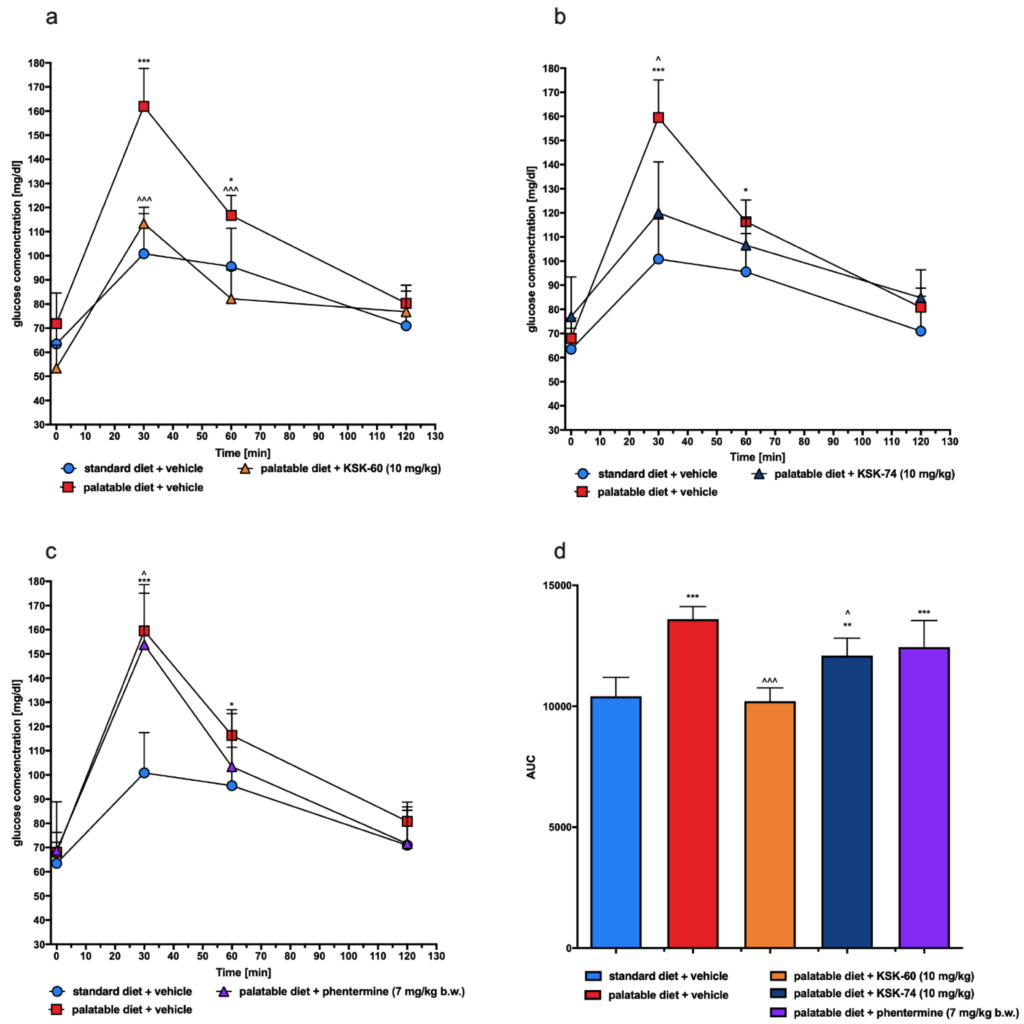
Glucose tolerance test. Results are expressed as means ± SD, n = 6. (a–c) Intraperitoneal glucose tolerance test (IPGTT): multiple comparisons were made using two-way ANOVA, Tukey’s post hoc tests. (d) Area under the IPGTT curve: comparisons were made using one-way ANOVA, Tukey’s post hoc test. * Significant vs. standard diet + vehicle group; ^ significant vs. palatable diet + vehicle group; *, ^ < 0.05, ** p < 0.01, ***, ^^^ p < 0.001.
2.9. Effect of KSK-60, KSK-74, or Phentermine on Spontaneous Activity
Spontaneous activity was measured after the 1st (single dose) and 27th (multiple doses) administrations of the tested compounds. The compound KSK-60 after a single administration at a dose of 10 mg/kg b.w. reduced spontaneous activity at the 17th hour of measurement, while, after the repeated administration of this compound, we observed a reduction in spontaneous activity at the 15th hour of measurement. A single injection of phentermine decreased spontaneous activity at the 17th hour of measurement, while, after multiple administrations of this compound, we recorded an increase in spontaneous activity at the 2nd hour of measurement. The single and repeated administrations of compound KSK-74 did not affect spontaneous activity in rats (Figure 13).
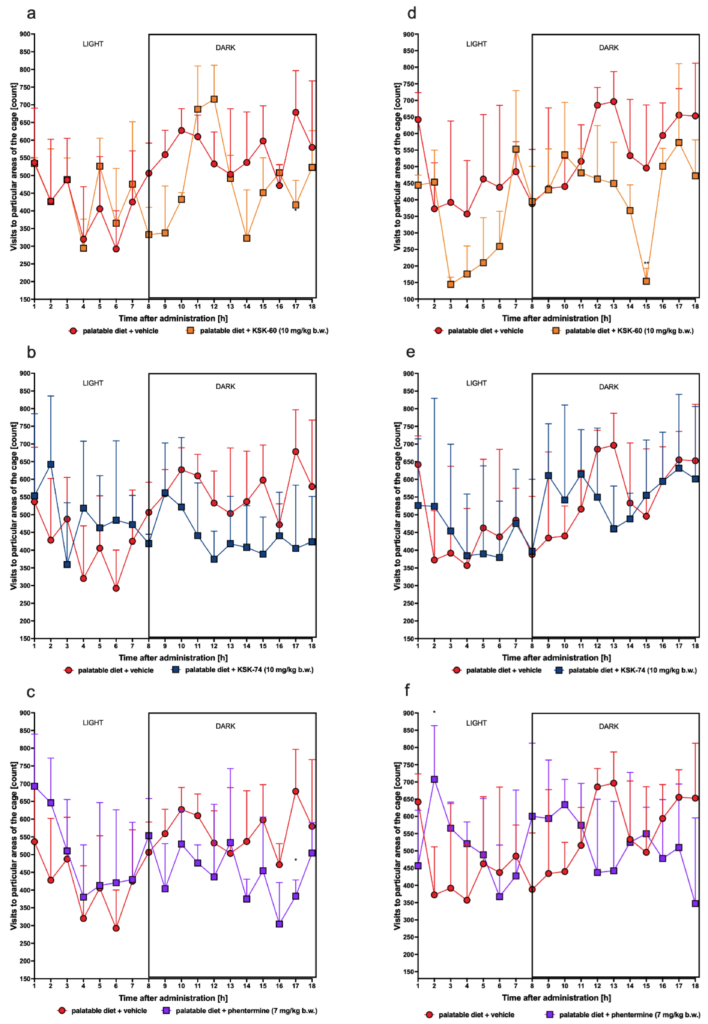
Spontaneous activity after the 1st and 27th administrations of the tested compounds. Results are expressed as means ± SD, n = 6. Comparisons were made using Multiple t-test; (a) palatable diet + vehicle vs. palatable diet + KSK-60 after the 1st administration; (b) palatable diet + vehicle vs. palatable diet + KSK-74 after the 1st administration; (c) palatable diet + vehicle vs. palatable diet + phentermine after the 1st administration; (d) palatable diet + vehicle vs. palatable diet + KSK-60 after the 27th administration; (e) palatable diet + vehicle vs. palatable diet + KSK-74 after the 27th administration; (f) palatable diet + vehicle vs. palatable diet + phentermine after the 27th administration; * p < 0.05, ** p < 0.01.
2.10. Effect of KSK-60, KSK-74, or Phentermine Administration on Plasma Corticosterone
There was no significant change in plasma corticosterone levels between different groups of rats. In this experiment, the tested compounds had no effect on the plasma corticosterone levels of rats. Its plasma concentrations ranged between 120–155 pg/mL.
2.11. Pharmacokinetic Analysis
The pharmacokinetic (PK) parameters calculated using non-compartmental analysis based on the concentration-time data after the single i.p. administration of the investigated compounds at a dose of 10 mg/kg b.w. are presented in Table 3. The maximal plasma concentration was attained by both compounds at the first sampling point (5 min after administration), and the values were almost identical (109 vs. 105 µg/L for KSK-60 and KSK-74, respectively). Both compounds also had identical half-lives equal to 2.7 h. However, the compound KSK-74 had much higher clearance due to the larger volume of distribution (272 vs. 513 L/kg for KSK-60 and KSK-74, respectively), indicating that it much easier, compared to the KSK-60, crossed the biological membranes, and distributed throughout the body.
| Parameter | KSK-60 | KSK-74 |
|---|---|---|
| Cmax [µg/L] | 109 | 105 |
| tmax [h] | 0.083 | 0.083 |
| λz [h−1] | 0.26 | 0.25 |
| t0.5λz [h] | 2.7 | 2.71 |
| CLS/F [l/h/kg] | 69.98 | 131.06 |
| AUC0-inf [mg∙h/L] | 514.40 | 274.67 |
| Vz/F [l/kg] | 272.63 | 513.14 |
| MRT [h] | 3.28 | 2.45 |
Estimated pharmacokinetic parameters (non-compartmental analysis) of the investigated compounds calculated from mean rat plasma concentration values (n = 3) after administration of a single i.p. dose of 10 mg/kg.
Cmax—maximal concentration, tmax—time to reach maximal concentration, λz—terminal elimination rate constant, t0.5λz—half-life, CLs—clearance, AUC0-inf—area under the concentration–time curve extrapolated to infinity, Vz—volume of distribution, MRT—mean residence time, F—bioavailability.
3. Discussion
In this study, we performed preliminary pharmacological experiments to determine the potential anti-obesity properties of two H3R ligands, KSK-60 and KSK-74, which are also ligands of sigma receptors. The effect of their chronic administration on body weight, selected metabolic parameters, and spontaneous activity of rats was investigated in the model of excessive eating of preferential feed. We also conducted studies that evaluated the intrinsic activity and selected pharmacokinetic parameters of these compounds. To take a closer look at the action of our selected ligands, we performed histopathological studies showing the numerical density of adipocytes and the pathological features of inflammation in peritoneal adipose tissue.
In our previous work, we published the results for their structural analogues, compounds KSK-59 and KSK-73, which differ only in the distal part of the molecules (acetyl versus propionyl derivatives, Figure 1) [22]. It should be noted that compound KSK-73 prevented weight gain and metabolic disturbances more than compound KSK-59, which is partially consistent with our current results, in which KSK-74 is also more effective than KSK-60. Although both compounds similarly inhibited weight gain in the excessive eating model, for the most part, only compound KSK-74 significantly compensated for metabolic disturbances that accompany obesity.
Comparing the structures of tested compounds, the eight carbon-chain homologues were characterized by higher efficacy in vivo for both acetyl and propionyl derivatives. However, our previous work showed that compounds with the highest affinity for H3R were not the most active in vivo [20,21]. Therefore, we suspect that the influence on body weight gain and metabolic activity of these ligands may be additionally related to another non-histaminic mechanism of action. Furthermore, the pharmacokinetic properties of compounds KSK-73 and KSK-74 are more favorable compared to their homologues KSK-59 and KSK-60. In particular, they have a much larger volume of distribution, which could indicate their better ability to freely cross biological membranes and distribute throughout the body [22]. Additionally, according to Lipinski’s “Rule of Five” (molecular weight ≤ 500; LogP ≤ 5; hydrogen-bond donors ≤ 5; hydrogen-bond acceptors ≤ 10; number of rotatable bonds ≤ 10), compounds KSK-60 and KSK-74 are likely to have good absorption and permeability. As for the good CNS penetration, compound KSK-60 meets 4 (molecular weight ≤ 400; LogP ≤ 5; hydrogen-bond donors ≤ 3; hydrogen-bond acceptors ≤ 7—calculated by CompuDrug Pallas System, USA) out of 4 criteria, while KSK-74 meets 3 of them (molecular weight is > 400) [25]. Based on the theoretical assumptions, it is likely that both of them are able to cross the blood–brain barrier. However, further studies are necessary to verify this hypothesis. Interestingly, the in vivo pharmacological activity of the tested ligands appears to correlate with the affinity at sigma-2 receptors, and the explanation of this phenomenon requires further extended research. Both the dual affinity at histamine H3/sigma-2 receptors and the significant in vivo activity of the KSK-73 and KSK-74 ligands give hope for the discovery of unique compounds among a wide variety of histamine H3R antagonists. Therefore, compounds KSK-73 and KSK-74 have been chosen as new lead structures for the development of H3/sigma-2 receptors ligands (the affinity ratios are 0.68 and 0.59 for KSK-73 and KSK-74, respectively) with anti-obese activity, and the mechanism of their action would be a subject of further studies.
The excessive eating model used in our study allows us to determine whether the studied compounds affect body weight in animals that have free access to high-calorie foods. It perfectly illustrates the unnecessary high caloric intake by overeating freely available tasty products rich in sugar and fat. It shows that the unlimited availability of tasty foods prompts the body to consume that particular food, even when extra calories are not needed and when such behavior can lead to a significant increase in body weight and the development of metabolic disorders over a short period of time. Animals have access to certain high-calorie foods, such as peanuts, cheese, milk with increased fat content, and chocolate, but also to the standard feed. Most importantly, feeding is not in any way forced [26,27]. Special diet not only induces obesity, but also contributes to metabolic disorders specifically caused by this condition. Therefore, such a model of excessive eating is considered to be an apparent imitation of human models of the obesogenic diet [28].
The effect of H3 receptor antagonists on food intake has already been described in the literature [20,21,22,29]. Since treated rats consumed a similar amount of calories to the control rats fed palatable feed, we speculated that, other than a reduction in caloric intake, mechanisms resulting in the lower weight gain in these animals are involved. We obtained similar results earlier when testing other ligands from this group of compounds, namely, not all of them decreased the amount of calories consumed [21,22]. We reported that i.p. administration of H3R antagonists KSK-60 or KSK-74 effectively and dose-dependently inhibited weight gain, and that this inhibition occurred parallel to the inhibition of fat gain. Interestingly, the animals treated with the tested compounds gained less weight than the animals that received phentermine, a drug used to treat obesity. We also observed that the most active ligands we described to date in the model of excessive eating were characterized by a significant affinity at the sigma-2 receptor [20,21,22]. We can speculate that the inhibition of weight gain may be related to H3R and sigma-2 receptors, making them dual ligands. However, more studies are needed to clarify this issue.
The obesity problem is primarily related to an increase in the volume of peritoneal fat. Previous studies have shown that histamine affects body weight not only by inhibiting appetite, but it also regulates visceral fat volume [4]. This fact is probably related to neuronal histamine activity, which can accelerate adipose tissue lipolysis by activating the sympathetic nervous system. The lipolysis process leads to the release of free fatty acids and glycerol, which can be used as energy substrates for the body and thus contribute to the maintenance of adequate energy homeostasis [30]. One of the main features of obesity is the abnormal metabolism of circulating lipids [31]. The excess calories supplied with food cause unused triglycerides to be stored in adipose tissue. In addition, in our experiment, we observed a significantly lower intraperitoneal fat gain in animals treated with the tested compounds, especially KSK-74, which was closely correlated with the lower body weight gain. Moreover, we noticed that the reduction in plasma triglyceride levels was also correlated with lower fat mass. During the development of obesity, adipose tissue can grow by hypertrophy, which is an increase in the size of adipocytes, or by hyperplasia, which is an increase in the number of adipocytes due to the recruitment of new cells [32]. The volume of adipocytes reflects the balance between lipogenesis and lipolysis, while the number of adipocytes reflects the balance between the proliferation, differentiation, and apoptosis of preadipocytes and the adipocytes [33]. In the early stages of obesity development, when excess calories are supplied to the body, there is an overgrowth of adipocytes that secrete adipokines. In a subsequent step, adipokines stimulate the formation of additional preadipocytes, which differentiate into mature adipocytes that protect the organism against some of the adverse metabolic consequences of obesity [34]. This concept was supported by a Wang et al. in a study conducted on mice fed a high-fat diet. These animals showed signs of visceral hypertrophy within 1 month [35]. We observed a similar phenomenon in our experiment. In animals in the control group fed palatable feed, we recorded significant adipocyte hypertrophy. Interestingly, in the group of animals that received KSK-74, we observed an increase in their numerical density, but not in size, which resembled the condition and shape of adipocytes from adipose tissue from rats fed a standard diet. Therefore, we can speculate that KSK-74 protects against the development of hypertrophy. On the other hand, phentermine did not show any positive effect on the numerical density of adipocytes. Given the current reports that there is a strong association between small adipocytes and increased insulin sensitivity, we can also speculate that the tested ligands for H3/sigma-2 receptors promote the formation of new adipocytes, protecting against the adverse consequences of obesity, including insulin resistance [36].
Many factors contribute to the formation of obesity, one of which is the hormonal state of the body. Information signals from the body’s periphery can be divided into those consisting of short-term signals that are generated during a meal and originate mainly from the gastrointestinal tract, and those that involve long-term signals provided by hormones that determine the body’s energy stores [37]. Among the hormones produced by adipose tissue, leptin and resistin deserve special attention. Their levels are closely correlated with the amount of adipose tissue [38,39].
Leptin is otherwise known as the satiety hormone, due to its main functions of regulating food intake and energy balance in the body. An increase in leptin levels sends a signal to the hypothalamus that energy reserves are full, and consumption can be completed; the effect is a reduction in appetite. Furthermore, high levels of leptin also increase energy expenditure (acceleration of metabolism). People who are overweight or obese have higher levels of leptin in plasma and adipose tissue [40]. In obesity, when leptin levels are high, the number of receptors for leptin is gradually reduced and their sensitivity to this hormone decreases. In this situation, the satiety signal that should normally inhibit appetite does not reach the brain [41,42]. In our experiment, in animals fed high-calorie products, we induced a state of elevated leptin levels. Animals treated with KSK-60 or KSK-74 maintained leptin levels at the same level as rats in the control group fed standard feed. Only in animals receiving KSK-74 did we observe lower leptin levels compared to rats in the control group fed palatable feed. This fact allowed us to conclude that the compounds we studied maintained leptin at an adequate level that allowed for the proper functioning of the hunger and satiety centers. These findings also allowed us to confirm that leptin levels were in direct correlation with levels of adipose tissue. Thus, maintaining optimal body fat levels is the best way to ensure physiological leptin levels and control excessive appetite and the development of obesity.
As with leptin, elevated levels of resistin are also observed in the state of excess adipose tissue. Ongoing mild inflammation is observed in overweight or obese individuals. Previous studies have shown that resistin levels correlate significantly with inflammatory markers. It is probably related to the fact that some proinflammatory cytokines, e.g., IL-6 or TNF-α, stimulate the expression of the resistin gene [43,44]. In our study, we noticed a similar relationship. In addition, elevated resistin levels can not only be a biomarker, but also a pathogenic factor for inflammatory diseases.
As mentioned above, a diet rich in high-calorie fatty foods may be the cause of mild chronic inflammation [45,46]. This condition can lead to changes in peripheral signaling associated with the insulin receptor, thereby reducing the sensitivity to insulin-mediated glucose release. These events result in elevated insulin and fasting glucose levels and decreased glucose tolerance, which may indicate that insulin resistance is developing [47]. In the model that we used, we also observed impaired glucose tolerance in the control group that had access to the palatable diet. However, a significant improvement in glucose tolerance was observed in experimental animals treated with the tested compounds. We suspected that this may be due to the fact that the experimental animals did not develop full obesity or to the effect of the tested ligands on H3R present in pancreatic β cells responsible for insulin secretion and blood glucose regulation [48].
In chronic inflammation, also known as metabolic inflammation, the immune cells responsible for infiltration of proliferating adipose tissue gradually turn into resident adipose tissue macrophages (ATMs). ATMs are classified by the expression of different markers, including pro-inflammatory ones, such as IL-6, MCP-1 TNF-α, CD11c, and iNOS, among others [49]. IL-6 is a pro-inflammatory cytokine responsible for the regulation of inflammation and the defense mechanisms of the body. The level of IL-6 increases significantly in adipose cells in obesity, which is due to the presence of inflammation [50]. In our study, there were no significant differences in IL-6 level in adipose tissue between the control group fed standard and palatable feeds, but there was some upward trend in the level of this mediator in the group fed palatable feed. Perhaps a longer experiment would result in a higher increase in this pro-inflammatory interleukin. Only in animals treated with compound KSK-74 did we observed a decrease in the IL-6 level in adipose tissue. These observations correlate with the results on the severity of inflammation in the tissues tested. One of the first CC chemokines discovered and best described is monocyte chemoattractant protein-1 (MCP-1). Obese people have been shown to have higher levels of this chemokine in adipose tissue than non-obese people [51,52]. In our model, we observed a similar phenomenon of elevated levels of this chemokine in rats from a control group fed palatable feed. Similar to IL-6 levels, compound KSK-74 decreased MCP-1 levels in adipose tissue and therefore nullified the formation of inflammation. To date, many studies indicate that obesity caused by a high-calorie diet leads to the induction of multiple inflammatory pathways [53]. The inflammation that develops is a consequence of the hypertrophy of adipose tissue cells and the damage to cellular structures [54]. Consistent with the reports in the literature mentioned above, we also observed ongoing inflammation among control animals fed palatable food. Of the compounds tested, only compound KSK-74 inhibited the development of inflammation in obesity-exposed adipose tissue and the value of the inflammation index was comparable to the standard control. These results support the current reports that adequate adipogenesis and hyperplasia, or the ability to distribute fat between newly formed adipocytes without the need for significant adipocyte hypertrophy, attenuates inflammation and subsequent insulin resistance [55]. When using phentermine, a drug currently registered for the treatment of obesity, we did not observe significant differences.
Severe, especially chronic, stress can cause significant weight loss. The defense response to stress is the increased secretion of hormones, such as cortisol, in humans. In previous animal studies, the introduction of a stress factor has been shown to cause changes in locomotor activity and increased corticosterone secretion [56,57]. To confirm that our results of decreased weight gain are not related to stress or changes in spontaneous activity, we determined plasma corticosterone levels in experimental animals and monitored spontaneous activity after initial and chronic administration of the tested ligands. In our study, we did not observe changes in corticosterone levels in both control groups and between animals that received the test compounds. We also did not show any significant effect on spontaneous activity, allowing us to conclude that weight loss was not caused by the stress factor.
LIMITATIONS. The main limitation of this research is that it did not directly indicate that the described actions were really related to the influence on the histamine H3 or sigma receptors. Although we know from the earlier cited studies and from the intrinsic activity studies presented in this manuscript that the tested compounds are ligands for these receptors, further research is needed to confirm the mechanism of their activity. The second limitation was that the number of animals used in this study was small, and the effect on calorie intake requires further research.
…
5. Conclusions
In summary, the compounds we studied were potent H3 histamine and sigma-2 receptor ligands with proven efficacy in preventing weight gain in a rat model of excessive eating. The compound KSK-74 significantly compensates for metabolic disturbances that accompany obesity (plasma triglyceride, resistin, and leptin levels), improves glucose tolerance, and protects against adipocyte hypertrophy. Furthermore, KSK-74 inhibits the development of inflammation in obesity-exposed adipose tissue. The in vivo pharmacological activity of the tested ligands appears to correlate with the affinity for the sigma-2 receptors; however, the explanation of this phenomenon requires further and extended research.


